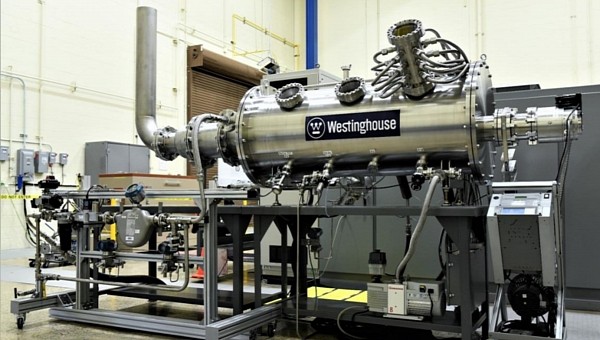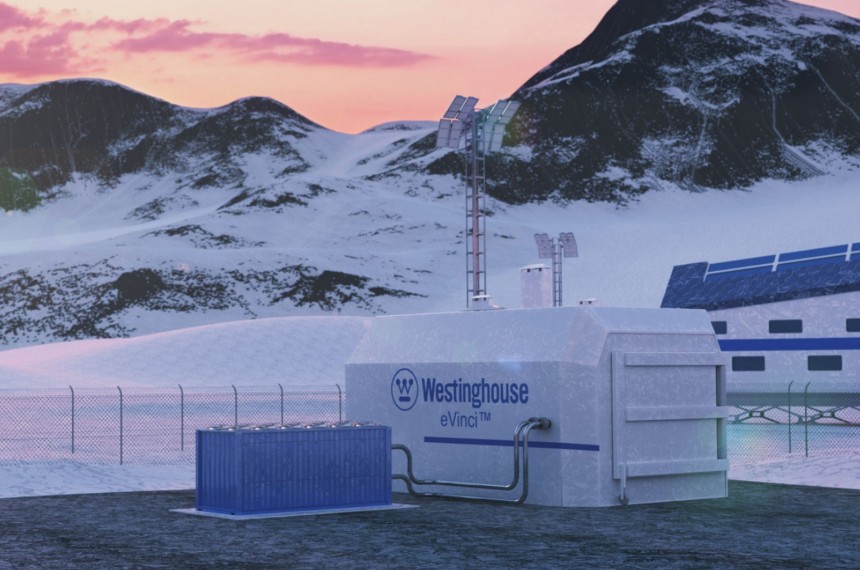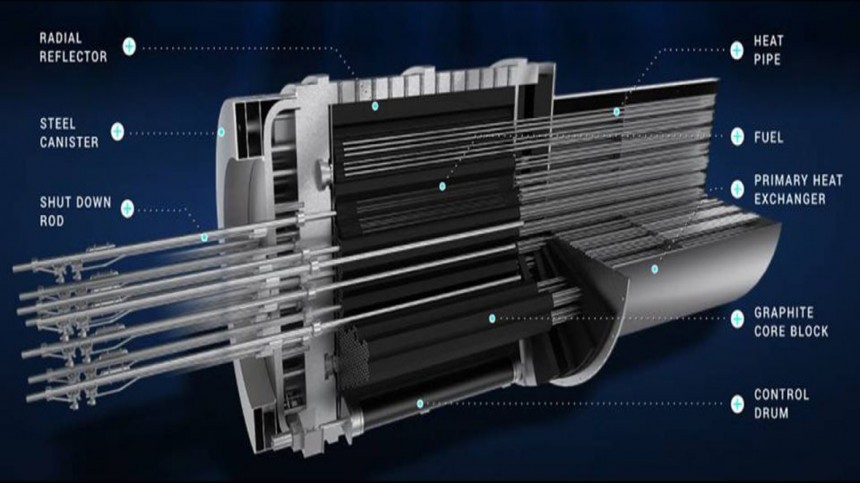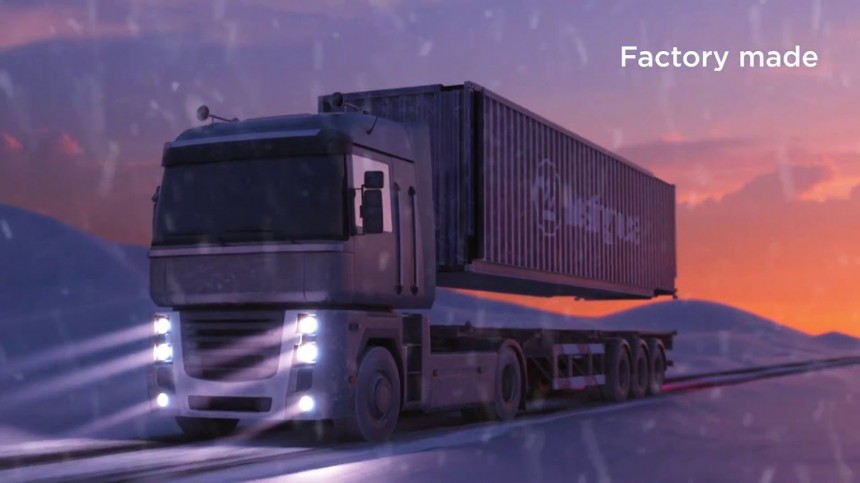It was easy to be awe-struck when the National Ignition Facility in Livermore, California, managed the first-ever ignition of a nuclear fusion reaction in December 2022. But nuclear fusion is still a pie-in-the-sky fantasy aspiration despite all the good news recently. That said, you shouldn't overlook what's been happening on the fission side of things.
That's the kind of technology far more likely to benefit all of our lives years or even decades before commercial nuclear fusion is even remotely possible. With this in mind, say hello to Westinghouse's eVinci microreactor. The small but furious nuclear reactor concept that can be mounted on the back of a truck.
But first thing's first, the eVinci? That name sounds like it was passed over on being the moniker for some plug-in electric hybrid mom-mobile. Questionable naming schemes aside, the eVinci microreactor takes its inspiration from a plethora of different methods of fission power and scales it down to a size that isn't unwieldy or cumbersome.
From large-scale commercial reactors and even design studies for nuclear reactors in space, Westinghouse's nuclear energy division, based near Pittsburgh, Pennsylvania, is one of the most experienced teams in America in its field. It's not hard to fathom all the coal-fired and oil-burning power stations across the globe that could benefit from replacing their current infrastructure with a completely carbon-free source of electricity.
Though fission reactors come in all shapes and sizes, nearly all of them work on similar working principles. Nuclear fuel rods arranged together in a fissile core are surrounded by a neutron-moderating material, usually graphite. Meanwhile, the thermal energy from critical fissile reactions is captured via a cooling fluid, some form of gas or liquid, and used to generate usable electricity. in the case of eVinci, its heat pipes interact directly with ambient are, creating heat convections that can be used to power everything from factories to office buildings and even a large stadium.
Whether through steam-driven drive shafts or through heat-radiating pipes as with eVinci, all this power winds up in the same place. Using radically different design languages from larger reactors, Westinghouse's heat-pipe reactor theoretically outputs respectable power compared to larger reactors using light water, heavy water, or both, to cool the fission core. To scale this tech down to a form factor that fits on the back of an 18-wheeler trailer is a feat within itself.
On first impression, the eVInci heat pipe microreactor almost resembles a large gas canister more so than it does a mobile power generating station. Inside this large metal cylinder, nuclear fuel rods of particularly high quality are arranged into a compact but powerful fissile core with large metal heat transfer pipes running through the core's center. This fissile fuel is known as Tri-structural isotropic particle fuel, or TRISCO for short. It consists of a proprietary blend of Uranium isotopes mixed with carbon and oxygen to form a fuel kernel the size of a poppy seed.
These highly enriched and energy-potent fissile fuel pellets can theoretically remain critical without the need for refueling for up to eight years. At this point, the whole device can be packed into a shipping container and sent back to Westinghouse's facility in Cranberry Township, Pennsylvania, for proper disposal of spent nuclear fuel rods. On top of that, Westinghouse reckons it's possible to install an eVinci power station in as little as 30 days.
The eVinci system, with a bare minimum of moving parts to contend with and the latest in computer-controlled autonomous operation software, can theoretically operate unattended for days or even weeks. All the while, the reactor can be remotely monitored via top-notch sensor arrays that give real-time updates to the reactor's condition at the click of a mouse.
Add it all up, and you have a pint-sized fission reactor capable of delivering up to five megawatts of electrical power and up to 13 megawatts of thermal energy out of a system that could fit comfortably inside an average-sized warehouse. Its diminutive size allows for the number of applications the eVinci system can accommodate to far exceed that of far larger and more complicated fission reactors.
From the private civilian sector to the military-industrial complex, there's no shortage of places that could make use of a reactor that small. Power stations operating with highly noxious and toxic petrochemicals, account for more deaths than nearly any other form of pollution attributed to modern climate change.
Though nuclear energy is by no means guaranteed to be totally safe, you'll be happy to know there hasn't been a nuclear accident attributed solely to human error or incompetence since Chornobyl. Because eVinci can theoretically operate with a fraction of the fissile fuel as the average RBMK reactor, chances are good the conditions that caused the Chornobyl disaster are essentially slim to none with this novel variety of nuclear reactors.
At the moment, Westinghouse anticipates the first full-scale commercial eVinci system should be ready for deployment sometime in 2025. Under this plan, eVInci has the potential to be installed one at a time in various locations or in pairs of multiple reactors running in parallel. A $9 million investment from the U.S. Department of Energy should be a big help in bringing this remarkable concept to reality.
The prospects of a whole fleet of eVinci Mircroreactors replacing great swaths of dirty, cancer-causing petrochemical power stations sounds like music to our ears. With further assistance from doctoral students at Texas A&M University as well as the famous Los Alamos Laboratory of Manhattan Project fame, there's some serious industry horsepower behind what's looking like one of the most promising reactor designs yet.
If nothing else, a stronger, more robust nuclear power grid in America could leave just a little bit more hydrocarbons for ICE cars to eat through before they go the way of the dodo. For that reason, we should probably root for Westinghouse to succeed. We invite you to check out a super awesome video detailing eVinci's remarkable construction. It's some properly interesting stuff.
But first thing's first, the eVinci? That name sounds like it was passed over on being the moniker for some plug-in electric hybrid mom-mobile. Questionable naming schemes aside, the eVinci microreactor takes its inspiration from a plethora of different methods of fission power and scales it down to a size that isn't unwieldy or cumbersome.
From large-scale commercial reactors and even design studies for nuclear reactors in space, Westinghouse's nuclear energy division, based near Pittsburgh, Pennsylvania, is one of the most experienced teams in America in its field. It's not hard to fathom all the coal-fired and oil-burning power stations across the globe that could benefit from replacing their current infrastructure with a completely carbon-free source of electricity.
Though fission reactors come in all shapes and sizes, nearly all of them work on similar working principles. Nuclear fuel rods arranged together in a fissile core are surrounded by a neutron-moderating material, usually graphite. Meanwhile, the thermal energy from critical fissile reactions is captured via a cooling fluid, some form of gas or liquid, and used to generate usable electricity. in the case of eVinci, its heat pipes interact directly with ambient are, creating heat convections that can be used to power everything from factories to office buildings and even a large stadium.
On first impression, the eVInci heat pipe microreactor almost resembles a large gas canister more so than it does a mobile power generating station. Inside this large metal cylinder, nuclear fuel rods of particularly high quality are arranged into a compact but powerful fissile core with large metal heat transfer pipes running through the core's center. This fissile fuel is known as Tri-structural isotropic particle fuel, or TRISCO for short. It consists of a proprietary blend of Uranium isotopes mixed with carbon and oxygen to form a fuel kernel the size of a poppy seed.
These highly enriched and energy-potent fissile fuel pellets can theoretically remain critical without the need for refueling for up to eight years. At this point, the whole device can be packed into a shipping container and sent back to Westinghouse's facility in Cranberry Township, Pennsylvania, for proper disposal of spent nuclear fuel rods. On top of that, Westinghouse reckons it's possible to install an eVinci power station in as little as 30 days.
The eVinci system, with a bare minimum of moving parts to contend with and the latest in computer-controlled autonomous operation software, can theoretically operate unattended for days or even weeks. All the while, the reactor can be remotely monitored via top-notch sensor arrays that give real-time updates to the reactor's condition at the click of a mouse.
From the private civilian sector to the military-industrial complex, there's no shortage of places that could make use of a reactor that small. Power stations operating with highly noxious and toxic petrochemicals, account for more deaths than nearly any other form of pollution attributed to modern climate change.
Though nuclear energy is by no means guaranteed to be totally safe, you'll be happy to know there hasn't been a nuclear accident attributed solely to human error or incompetence since Chornobyl. Because eVinci can theoretically operate with a fraction of the fissile fuel as the average RBMK reactor, chances are good the conditions that caused the Chornobyl disaster are essentially slim to none with this novel variety of nuclear reactors.
At the moment, Westinghouse anticipates the first full-scale commercial eVinci system should be ready for deployment sometime in 2025. Under this plan, eVInci has the potential to be installed one at a time in various locations or in pairs of multiple reactors running in parallel. A $9 million investment from the U.S. Department of Energy should be a big help in bringing this remarkable concept to reality.
If nothing else, a stronger, more robust nuclear power grid in America could leave just a little bit more hydrocarbons for ICE cars to eat through before they go the way of the dodo. For that reason, we should probably root for Westinghouse to succeed. We invite you to check out a super awesome video detailing eVinci's remarkable construction. It's some properly interesting stuff.










